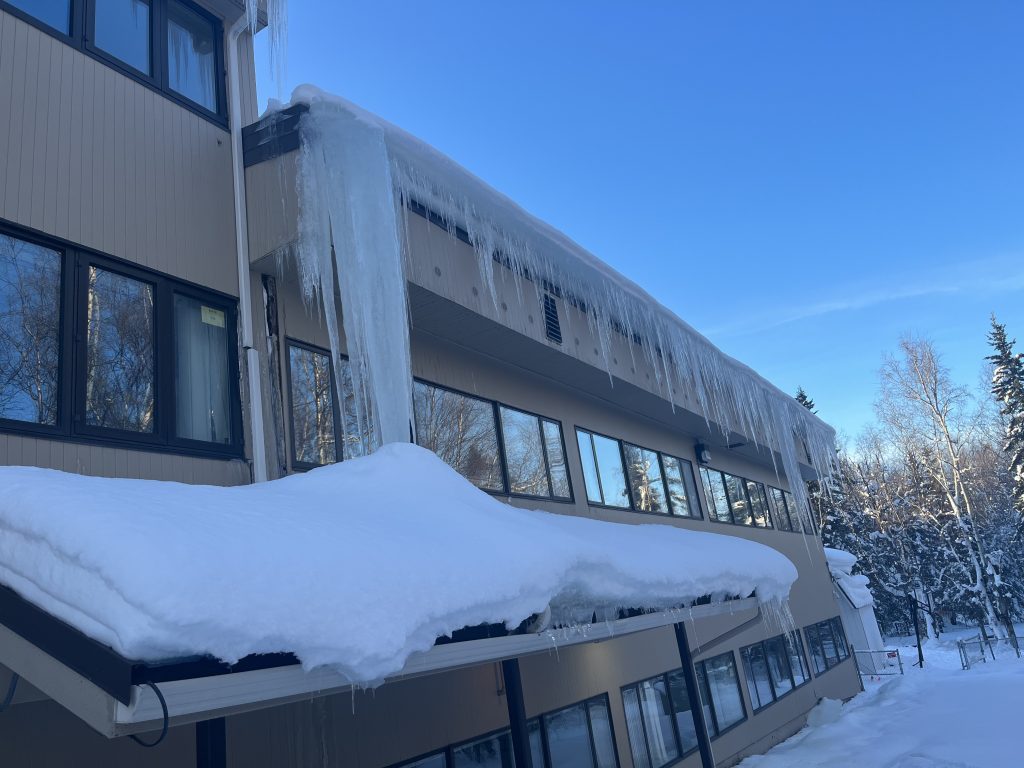Gosh what a year, and it’s only the first week of February! Here at Gage, we’ve been offering snow removal from roofs for over 15 years but as I’m sure everyone knows and feels, this year we’ve seen an unprecedented volume of snow – and calls.
In what’s normally more of our “off season”, we’ve ramped up to having 10 crews out and still can’t keep up with demand. As a homeowner, it’s certainly stressful to be worrying about the potential for damage either from the snow load or from leaks. As a company where “Eager to Please” is part of our motto, it hurts to not be everywhere all at once serving our community. Especially with the added pressure of buildings collapsing.
While it’s hard to have predicted the reality of so much snow this winter, we’ll dig in on what ice damming is, how it causes leaks, and what can be done to prevent damage. Prevention really is the best solution to alleviate the risk of damage to homes and to safeguard your property.
Understanding Snow Loads
Snow loads refer to the weight of snow and ice accumulated on a roof. This weight exerts pressure on the roof structure, potentially leading to structural damage if it exceeds the load-bearing capacity. Factors such as the density of the snow, duration of accumulation, and local climate influence snow load severity. Homes with steeper pitched roofs are less likely to retain snow for longer periods of time, alleviating snow loads, while flat roofs and some low-pitched roofs are at higher risk of structural damage because they retain snow loads.
Ice Damming and its Causes
Ice damming occurs when snow on a roof melts, then refreezes near the eaves, creating a literal dam — a barrier that prevents proper drainage. This trapped water can seep under shingles, causing leaks and water damage inside the home. Several factors contribute to ice dam formation:
1. Temperature Variations: Fluctuating temperatures and/or heat from the sun cause snow to melt during the day and refreeze at night, promoting ice dam development.
2. Inadequate Insulation: Poor attic insulation allows heat to escape, warming the roof and melting snow.
3. Improper Ventilation: Inadequate attic ventilation traps warm air, accelerating snow melting.
4. Roof Pitch: Low-pitched roofs are more susceptible to ice damming as they retain snow for longer periods.
Leakage from Ice Damming
When ice dams form, they create a barrier that prevents melted snow from properly draining off the roof. As a result, water can back up under shingles, infiltrating the roof deck and causing leaks. These leaks often manifest as water stains on ceilings, damaged insulation, and even structural deterioration over time. We often get calls about leaks starting when periods of warm weather occur and/or when it’s been particularly sunny.
The design of your house can make it more or less susceptible for leaks. Houses with longer eaves are less likely to experience leaks, while homes with fireplaces are often more susceptible to leaking, either from poor attachments or excess heat.
Preventative Measures for Homeowners
1. Insulate Attics: Adequate attic insulation helps maintain consistent temperatures, preventing snow from melting unevenly and reducing the risk of ice dams.
2. Improve Ventilation: Proper attic ventilation ensures that warm air escapes, keeping the roof surface cool and minimizing snow melting.
3. Install Roof Heating Cables: Roof heating cables (also called heat tape) can be installed along the eaves to melt snow and prevent ice dam formation. While helpful when they work, roof heating cables can be unreliable.
4. Clear Debris: Regularly remove debris such as leaves, branches, and accumulated snow from the roof to prevent ice dam formation.
5. Use a Roof Rake: Safely remove excess snow from the roof using a roof rake, especially after heavy snowfalls.
6. Seal Air Leaks: Seal gaps and cracks in the attic to prevent warm air from escaping, reducing the risk of snow melting and ice damming.
7. Professional Inspection: Schedule regular roof inspections by a qualified professional to identify potential issues and address them before they escalate.
Consider employing the help of an expert to ensure further damage isn’t done. If you’re having a professional removal, make sure to mention the presence of skylights, solar panels, and heating cables/heat tape if they’re not easily visible.
Conclusion
As winter brings picturesque landscapes, it also poses challenges for homeowners in the form of snow loads, ice damming, and roof leaks. Understanding the mechanisms behind these phenomena and implementing preventative measures is essential for protecting your home and avoiding costly repairs. By insulating attics, improving ventilation, and practicing regular maintenance, you can minimize the risk of damage and enjoy a worry-free winter season. Stay proactive, stay safe, and safeguard your home against the winter elements.
We’re doing our absolute best to serve everyone as fast as we can while maintaining the integrity of our work. We’re grateful to our community for showing compassion and patience during this time.
We’re serving Anchorage, Eagle River, Chugiak, Palmer, Wasilla and areas such as Bird Creek, Girdwood, Big Lake, Houston, and Willow as possible.
